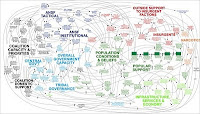 Last month a Philadelphia marketing executive posed this question to the Advertising Professionals group on LinkedIn: “In one sentence, what is advertising?”
Last month a Philadelphia marketing executive posed this question to the Advertising Professionals group on LinkedIn: “In one sentence, what is advertising?”As of today there are 195 answers – and counting.
The answers have ranged from academic to streetwise, and a few discussions broke out along the way. There’s even been a whiff of consumerism.
My own answer was: “Advertising communicates between buyer and seller, and in the modern day it’s successful when it starts a dialogue.”
Some other interesting ones were:
Erudite. “Creating an equity position among a target market that reaches and motivates a sufficient number of consumers so a business can realize a specific growth objective.” (James E. Friedman)
Mercantile. “The equivalent of having 5,000 sales people on the road.” (David West)
Uncomplicated. “The art and science of enticing buyers to purchase a particular product or service.” (Ted Rossman)
Personal. “Advocating for a product, service or social movement, etc., the practitioner believes in.” (Doreen Dvorin)
The protagonist, John Cooley, said he was asking for material to include in a presentation. I followed up with him this week to see how it went, and above all, what definition did he use?
The answer: "Hey Steve, It was perfect because my talk was about how many definitions we have for Advertising. I used many of them (quotes) from around the world and with the brightest minds in advertising. Thanks for asking."
At some risk, I offer you the opportunity to comment below. In one sentence, what is advertising?




